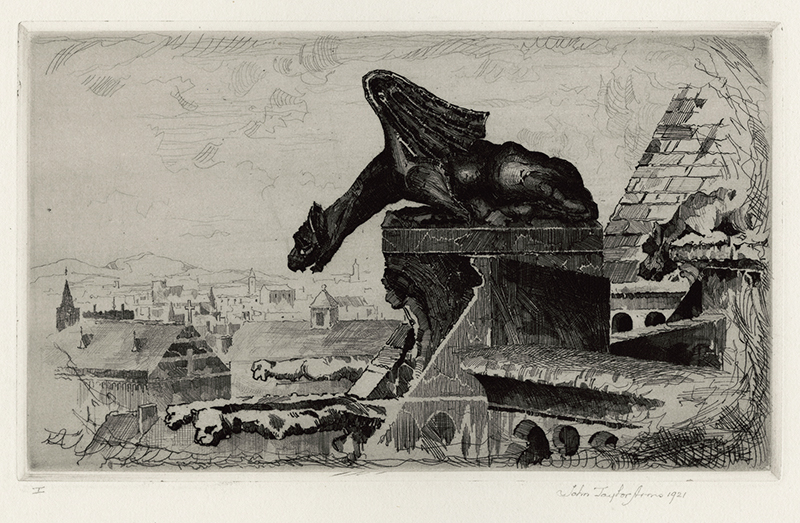Watching the People Below is an etching created by American master etcher, John Taylor Arms. It is pencil signed and dated 1921 and further inscribed with I in the lower left and SP in the margin near the sheet edge. Despite being dated 1921, this impression was printed in 1937 by David Strang and is on a sheet of antique-white wove Arnold paper with a partial watermark. The references are Fletcher 102, Arms 103, and Library of Congress 520. The edition size is 75 and the image measures 4-7/8 x 8-1/8 inches platemark.
The UNESCO website offers this description of Amiens cathedral: Located in the Hauts-de-France region, in the Department of the Somme, Amiens Cathedral is one of the largest churches in France and one of the most complete 13th century Gothic churches. The rigorous coherence of its plan, with the perfect symmetry of the nave and choir on either side of the transept, the beauty of its three-tier interior elevation, the audacious lightness of its structure that marks a new stage towards the conquest of luminosity, the wealth of its sculpted decoration and its stained glass makes it one of the most remarkable examples of medieval architecture.
Chimera, also called grotesques, are ornamental and some believe they were place on cathedrals to ward off evil sprints. They are often located above gargoyles. In Watching the People Below, the winged, long-necked chimera guards from his perch looking past three horizontal gargoyles.
John Taylor Arms, printmaker, lecturer, illustrator, and administrator, was born in Washington, D.C. on 19 April 1887. He first studied law at Princeton University but transferred to the Massachusetts Institute of Technology to study architecture. He studied with Ross Turner, David A. Gregg, and Felton Brown and earned his Master’s Degree in 1912. Following his graduation, Arms worked for the architectural firms Carrere and Hastings, and Clark and Adams before establishing his own architectural firm of which he was a partner.
A gift of an etching kit from his wife, Dorothy, changed the course of his life. He produced his first etching in 1915 and he eventually produced 441 prints, mostly etchings. Arms became one of the most famous printmakers of the first half of the twentieth century. He is mostly noted for his etchings of medieval architecture but early subjects also included ships, sailboats, airplanes, rural landscapes, and the streets, buildings, and bridges of New York.
Arms’ exhibition history was lengthy beginning in 1927 and continuing to 1952. He was given an honorary M.A. degree from Wesleyan University in 1939, and he was a member of the National Academy of Design; the Canadian Painters, Etchers and Engravings; the Royal Society of Painters, Etchers and Engravers; the Society of American Graphic Artists (served as the society's president); the National Institute of Arts and Letters; the American Federation of Arts; the American Artists Professional League; the Architectural League of New York; the Southern States Art League; the Southern Print Makers; the American Color Print Society; the North Shore Art Association; the Washington Water Color Club; the Chicago Society of Etchers; and the Cleveland Print Club.
He authored Hand-Book of Print Making and Print Makers in 1934 and illustrated Churches of France and Hills Town and Cities of Northern Italy by Dorothy Arms.
Arms was an activist for printmaking and assisted in assembling exhibitions of American graphic art that were shown in Sweden, Czechoslovakia and Rome; he was editor of the Print Department of Print, A Quarterly Journal of the Graphic Arts, and he lectured on the techniques, history and value of original prints. Arms also served as the president of the Tiffany Foundation in 1940.
The New York Public Library is the major repository of Arms’ work, but he is also represented in the collections of the Museum of Fine Arts Boston, Massachusetts; the Brooklyn Museum, New York; the Fogg Museum of Art, Harvard University, Cambridge, Massachusetts; the Art Institute of Chicago, Illinois; the Cleveland Museum of Art, Ohio; the Detroit Institute of Arts, Michigan; the Amon Carter Museum of American Art, Fort Worth, Texas; the British Museum and the Victoria and Albert Museum, London; the Los Angeles County Museum, California; the Metropolitan Museum of Art, the National Academy of Design, and the Whitney Museum of American Art, New York; the Fine Arts Museums of San Francisco, California; the Seattle Art Museum, Washington; the Library of Congress and the Smithsonian American Art Museum; Washington, D.C.; and the Worcester Art Museum, Massachusetts.
John Taylor Arms died in New York City on 15 October 1953.



